Trouble Shooting
For trouble shooting, these menus and log files will be investigated.
Transaction menu
Not all the failed transactions leave meaningful error messages, but Transaction menu is the starting point of the trace. If transaction menu does not provide the meaningful message or clue, the trace should proceed through the log files.
These errors are the examples for your understanding and reference. The trouble shooting list will be updated continuously.
Excel writer - No such file or directory
This error occurred at the ExcelWriter component. The error message says the file does not exist. This may mean the folder or file does not exist.
But this is the ExcelWriter component, the output file may not exist. That is not an error. So, this error was raised because the folder - /home/scott does not exist.
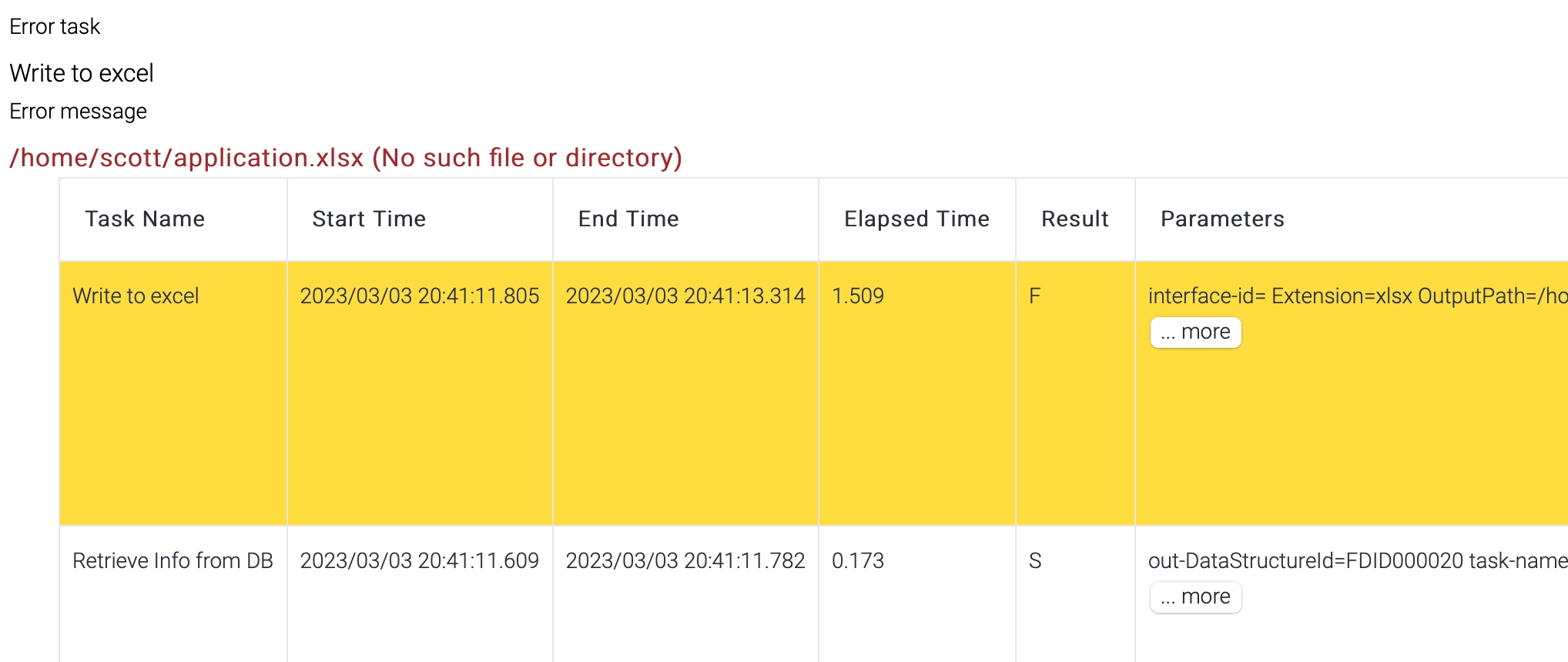
Parameter name does not exist - NNN
This error occurred at the Script component. But this is very general error. This means the parameter following this message does not exist. It can be a simple parameter or a part of hierarchical parameter. When this error occurs, the input data of the component need to be investigated for what parameters are passed to this error component.

These are the input data of the error component - Input Parameters/Input Data.

If the parameter does not exist in the input data and parameters, check where that parameter is supposed to be generated. If the parameter is expected from the external client, then trace the parameter from the start. Or if the parameter is generated in among the previous components, trace the parameter from the component.
Invalid return statement
This error occurred at the Function component. This error means JavaScript engine tried to evaluate the user entered JavaScript and failed. This error was raised when the contents of the script was wrong.

The script was this.

The correct format is this.

ReferenceError: NN is not defined
This error occurred at the Router component. The reference error means the JavaScript engine could not find any reference about NN variable.
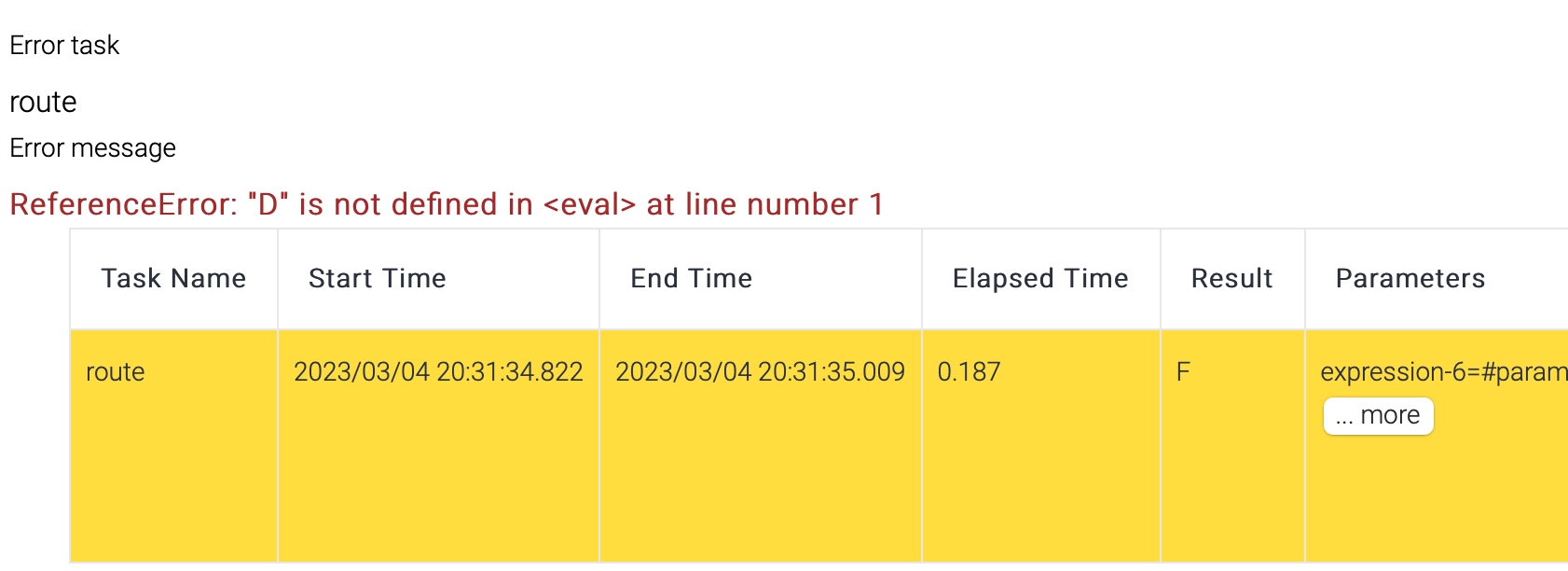
This is caused because of this expression.

The parameter from the request is D.
http://localhost:8080/api/RouterTest/v1?param=D¶m2=2
The expression above is translated to this.
D == 2
The left operand is a string and the right operand is a number. The left operand is treated as a variable, but no variable was found with the name D. That??�s why this error was thrown.
Matching target failed
This error occurred at the Router component. This error occurs when the Router component cannot find the true condition among the conditions.
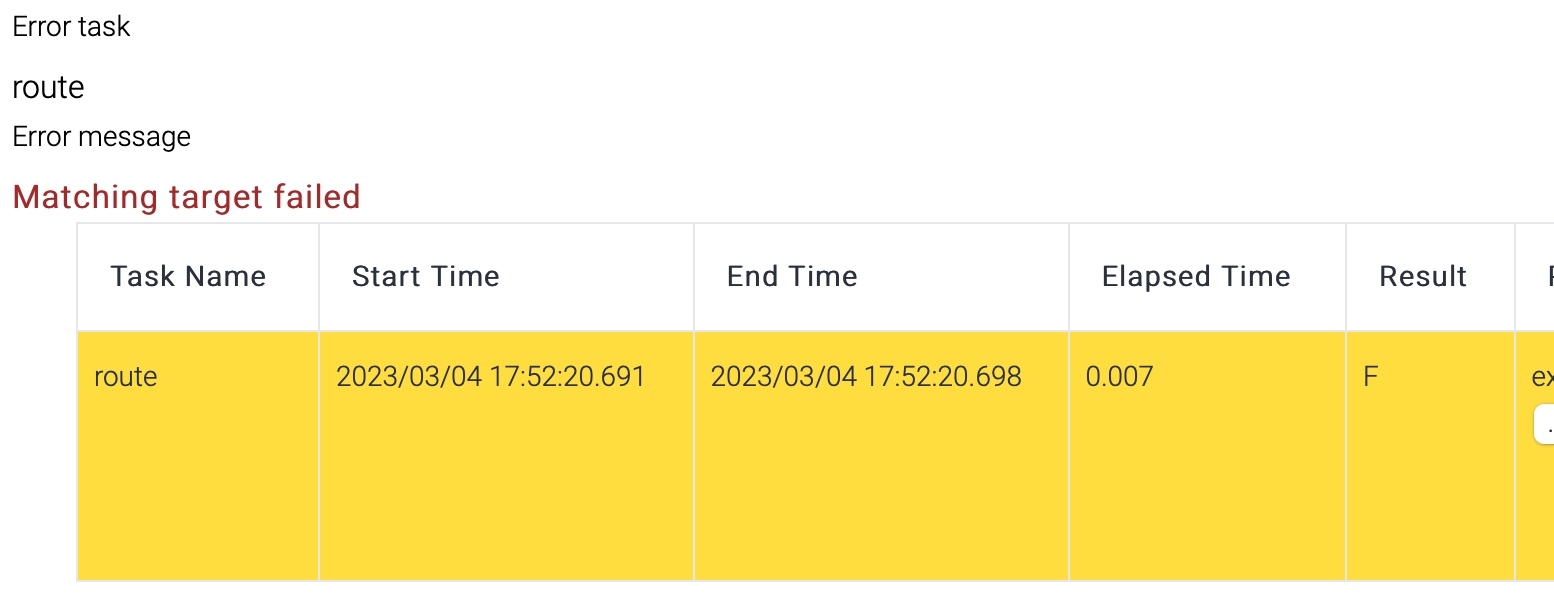
There are three conditions below. If the input parameters are these, this error occurs.
http://localhost:8080/api/RouterTest/v1?param=H¶m2=2
param = H, and all three conditions are evaluated as false.
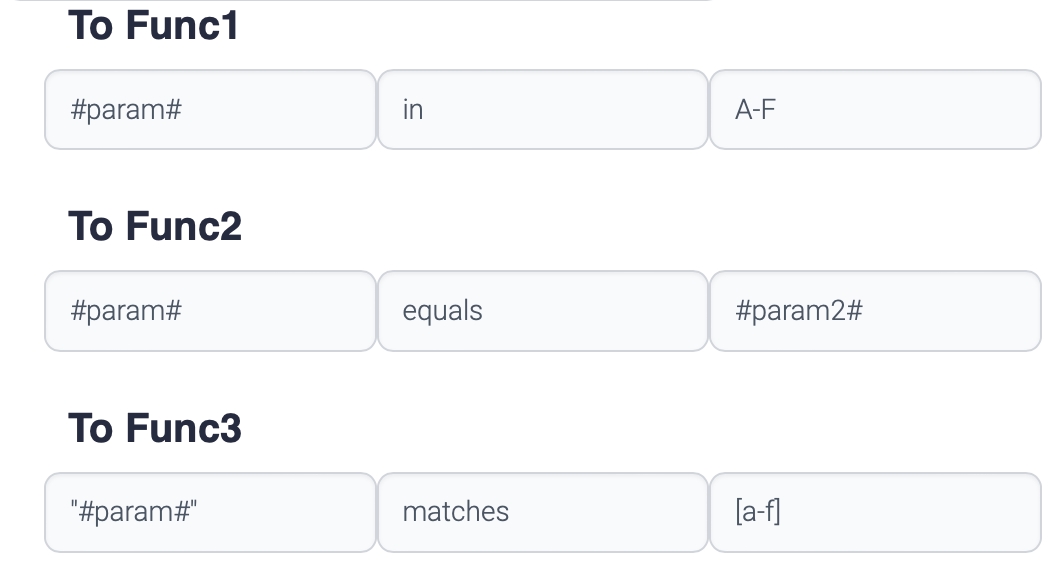
Error in your SQL syntax
The SQL syntax error occurred during the execution of the SQLExecutor component, which executes SQL queries against a database. This error can occur for many reasons, such as incorrect syntax in the SQL query, mismatched data types, missing or incorrect table or column names, or insufficient permissions. It's not easy to find the cause of the syntax error of the sql instantly because the transaction result shows only error message. It does not show the query generated or converted. You must construct the query yourself with the input parameter and data. Or you can get the generated query with the increased trace level on the SQLExecutor component.
With the generated query,
Check the syntax of your SQL query for any errors or typos
Verify that all table and column names referenced in the query exist in the database
Ensure that the data types of the columns being used in the query are compatible
Check that you have the necessary permissions to execute the query against the database
Use a SQL editor or tool to test and validate the query before executing it in the SQLExecutor component
By following these steps, you can diagnose and fix any SQL syntax errors that may occur in your flow.

No such file or directory
This error is generated by the FTPInput component. The error means either the remote file does not exist, or the local path is incorrect.

You need to check the input attributes of this component. Click "more button" to display the in/out attributes. The attributes which start with out- are output attributes. The error says that /home/herbi/transfer/usrtgtlist001.txt does not exist. This means the error is about the local directory.

For input string: " "
The error message "input string" indicates that there is an issue with the data being parsed or converted from a string to the expected data type. Although the error may initially occur at the FileInput component, it could potentially happen at any component that performs data parsing or conversion. In essence, the error message indicates that the input string does not conform to the expected format or data type.
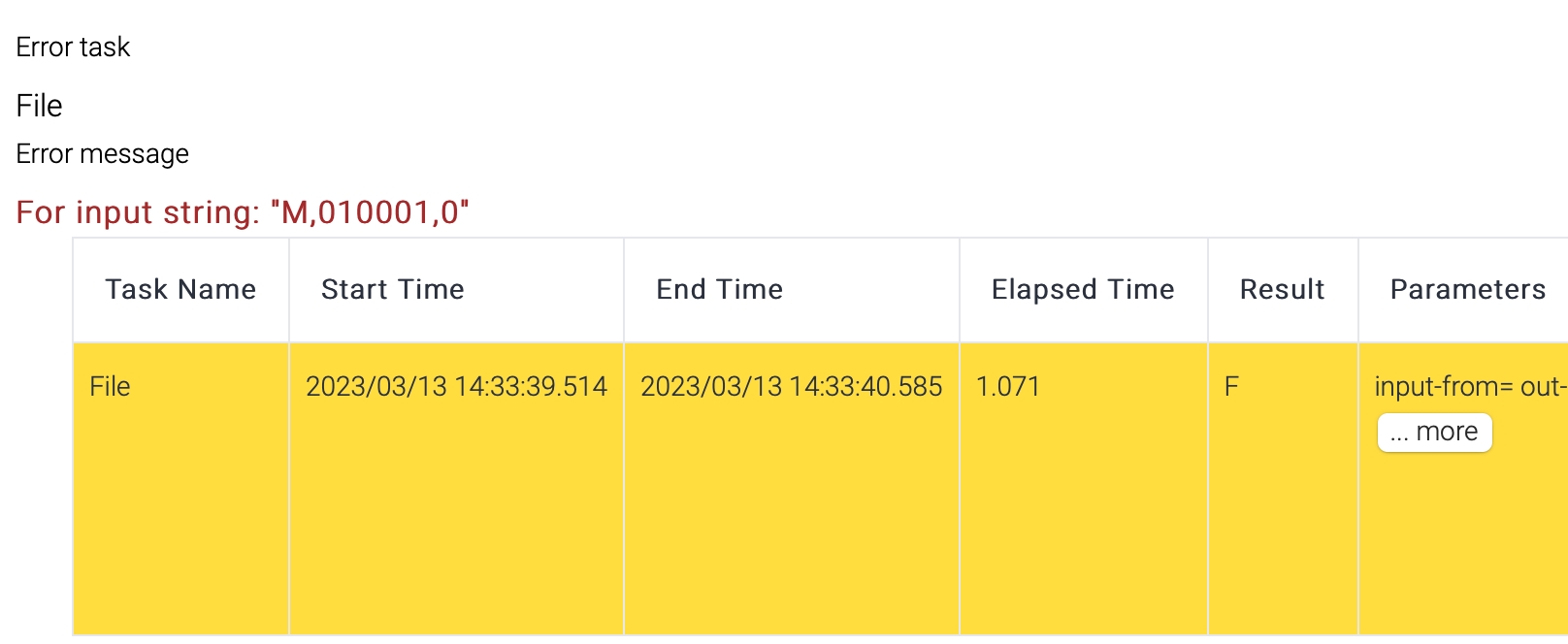
You need to check the data structure and input data. If the input data is correct, check the delimiters - record, field. If this error occurred at windows environment, the record delimiter may be the cause. For example, record delimiter is \n, but the input data contains \r\n.
If the input data has \r\n, the record delimiter is \n, and the component has Use Carriage Return attribute, then check that attribute. That attribute is used to check the existence of \r, and if exists, ignore that character while parsing the data.
Expected X fields, but Y fields are found
This error is generated by the FileInput component, but this error can happen at any component that performs data parsing. The error means X fields are registered in the data structure but only Y fields are found. And this happened at [M]aster or [D]etail field groups and the index of the data is [NN]. NN starts from 00. The error of the screenshot below means the component encountered an error while it was parsing the 2nd master field group or the 2nd instance of 1st master field group.

You need to check the input data whether the lengths of the fields are correct, or delimiters are correct, or the repeat count is correct. If the input data contains more than the expected records, it is assumed that another set of the data started.
Failed to change directory
This error is generated by the FTPOut component, and it is indicating that an attempt to change to a specific directory has failed. The error message usually includes a reason for the failure. For example, the error message might indicate that the specified directory does not exist, as shown in the capture below. In such cases, the error usually results from the incorrect directory being specified through the component's parameter or attribute.
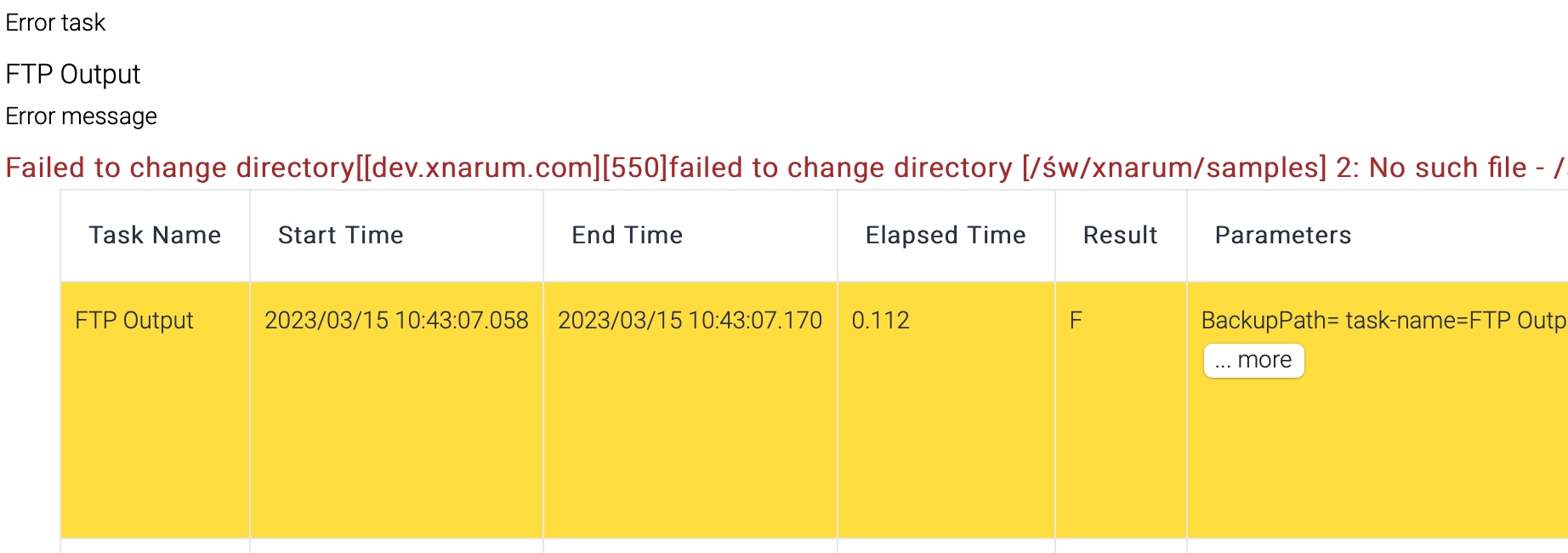
Failed to find rule from repository
This error is generated by the FileValidator component, which requires specific data structure information in order to parse and validate input data. This error typically occurs when an essential item - such as a data structure, field group, or field - is missing at runtime. The error message indicates that the missing item has not been published to the runtime environment, resulting in the failure of the validation process.
The "Failed to find rule" error is a common error that can occur in various components involving data structure, field group, field, or system information.
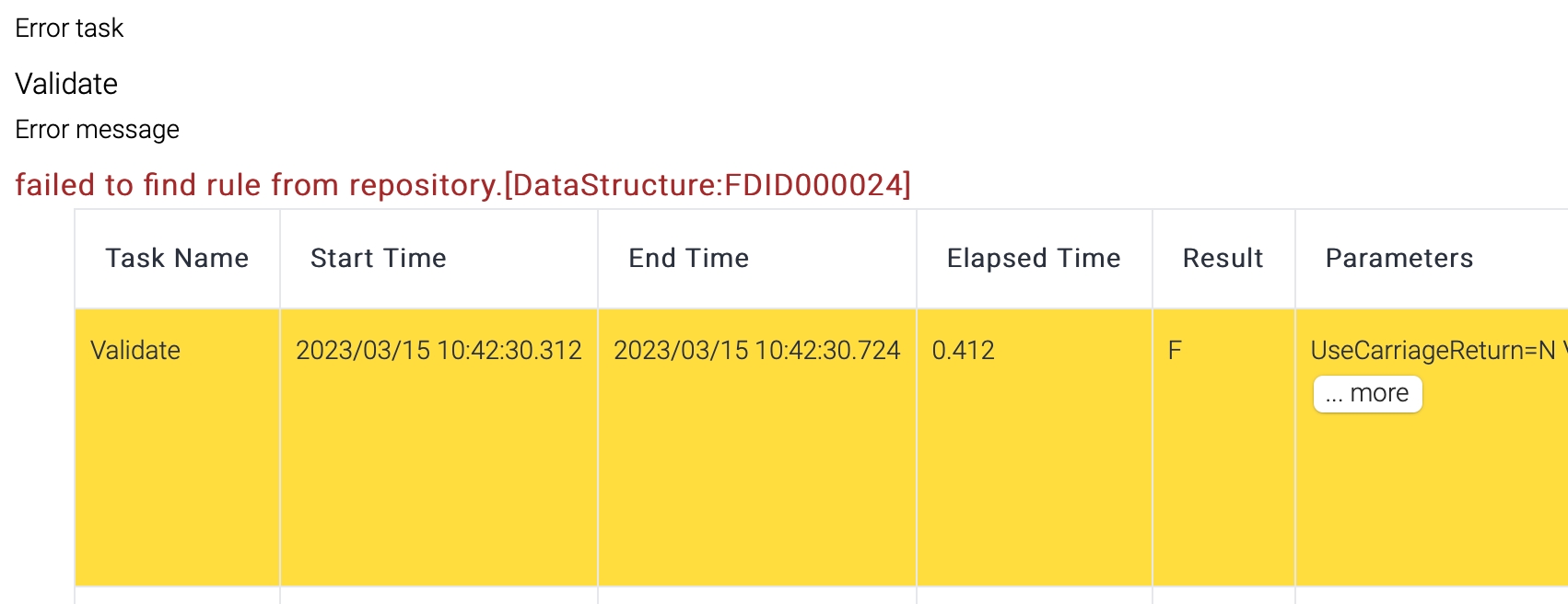
Filed exists. Overwrite or append option should be set
This error is generated by the FTPOut component when the output file already exists in the remote FTP server directory and the Write Mode attribute is skip.
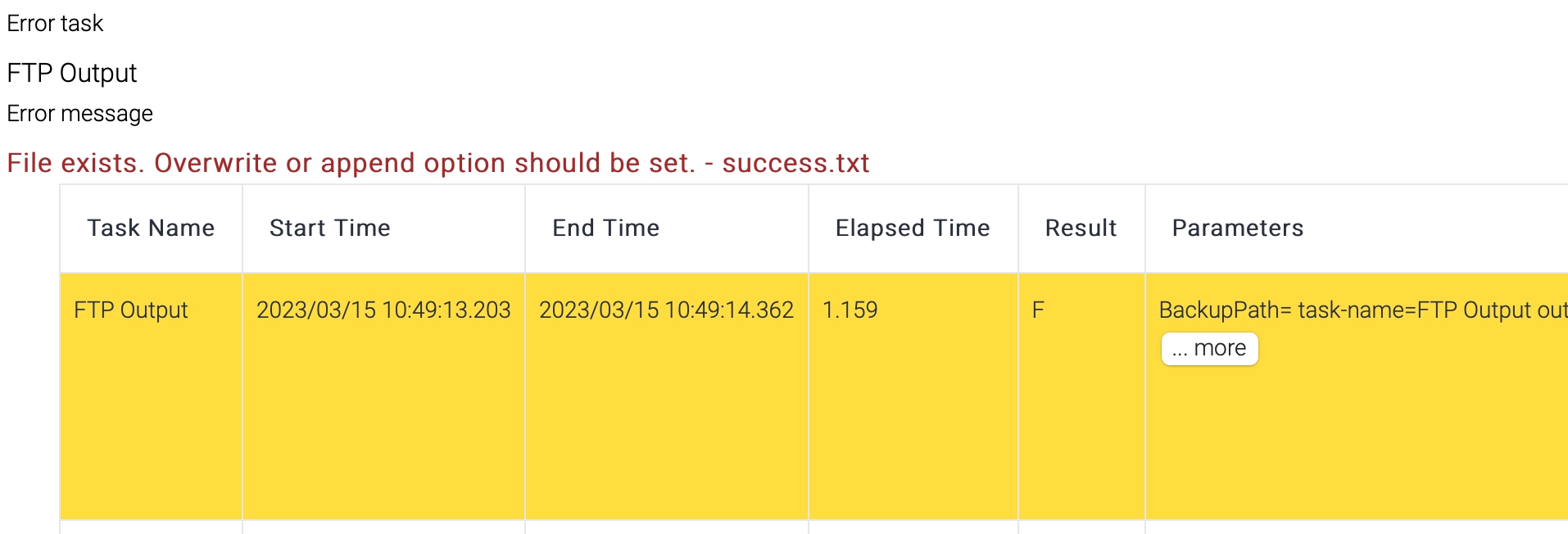
List is smaller than the index - N
This error occurs when an index value provided for a parameter exceeds the size of the elements contained within that parameter's list. In other words, the error message indicates that the specified index value is beyond the range of valid indices for that parameter. This error can be encountered in various scenarios involving lists or arrays, where an attempt to access an element at an out-of-bounds index results in the error message being generated.
N is the index which starts from 0. The error message below says that the list is smaller than 0. This means the list is empty.
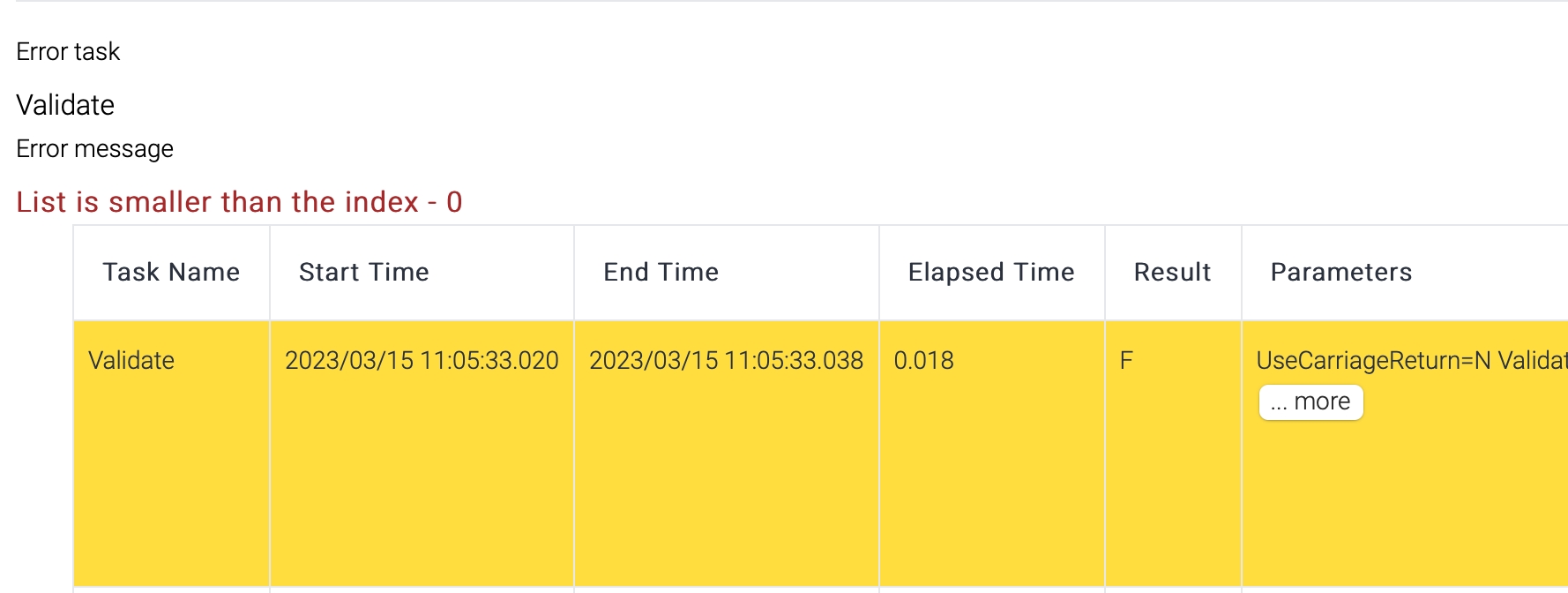
If you encounter this error, check which parameter has index value and whether the parameter has elements.

FileName attribute has index value but, ResultFiles is empty. That??�s the reason this error is thrown.

Record delimiter [] is not found at the expected position
This error is generated by the File components like FileInput, FileValidator, RecordExtractor. These components parse input file and generated parsed object. The input data from a file mostly contains multiple records with same layout. It may have a header part and body part which has repeated records. If the body part is repeated, the same delimiter as the header part is used between the records.
The error message below shows that the record delimiter of the 2nd master field group or the 2nd instance of the first master field group is not found at the expected offset. The current offset is 18 and the number of the parsed records are 6. This number is entire parsed count including header and body. New line(\n) is mostly used as a record delimiter, and this means 6 lines are parsed and the 7th line generated this error.
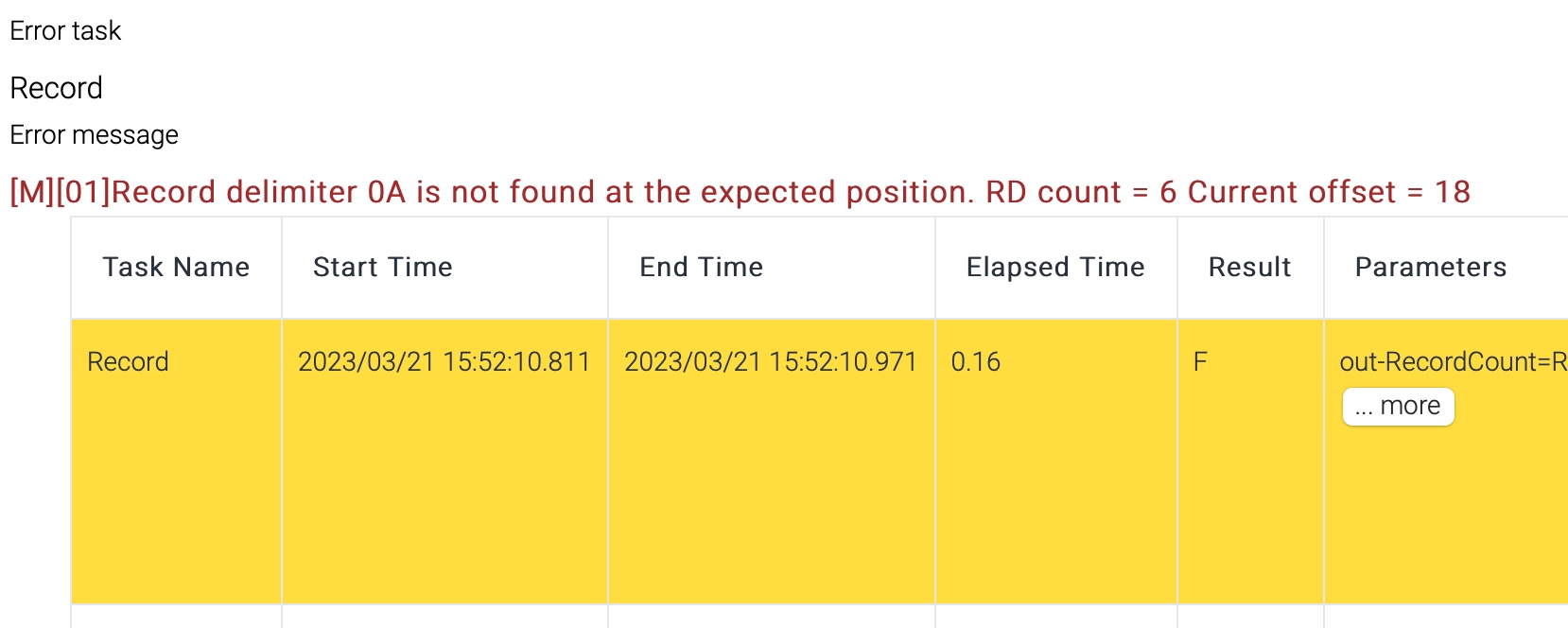
Failed to evaluate script
This error is typically generated by components that involve the use of JavaScript during their execution. In such cases, the JavaScript code is evaluated before it is executed, and if the evaluation process encounters an error, this error message is generated. This type of error can occur in a variety of scenarios, ranging from custom scripts to built-in components that rely on JavaScript for their functionality. In essence, the error indicates that there was an issue with evaluating the JavaScript code, which prevented the successful execution of the operation.
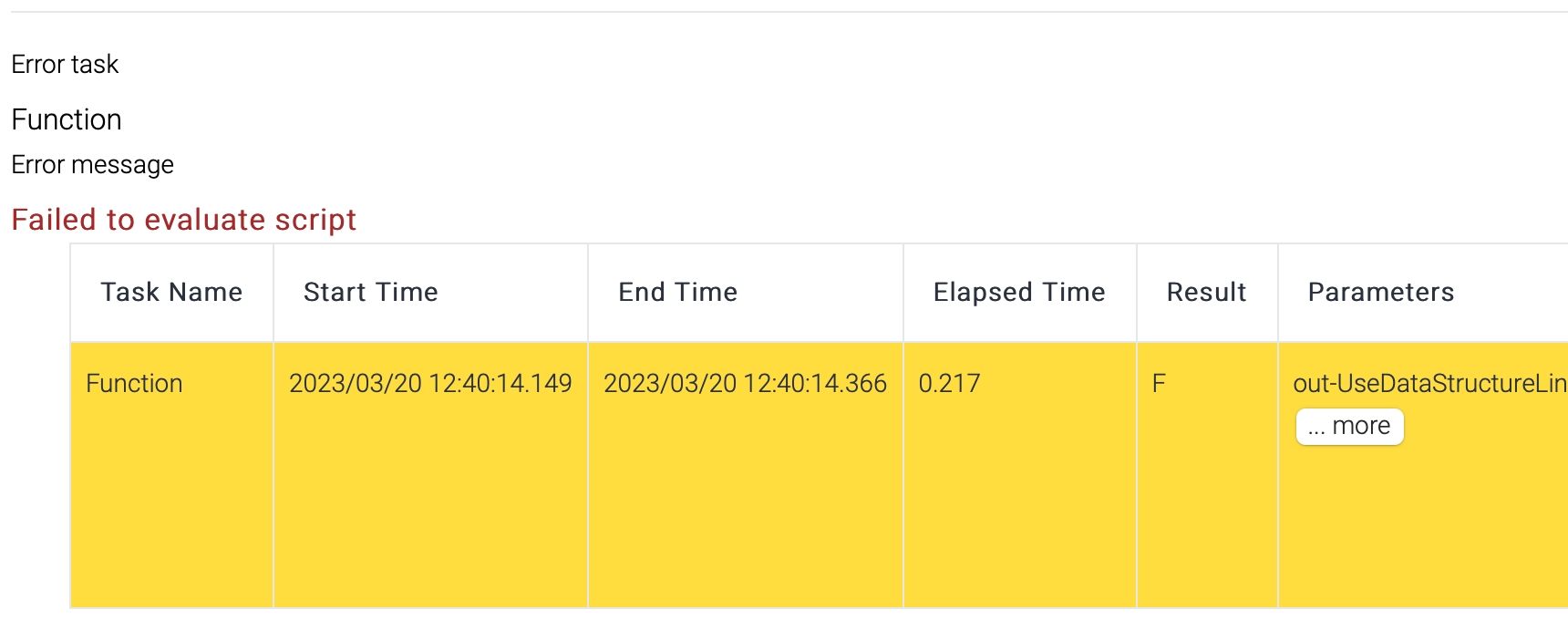
No message error
If you encounter an empty error message, it may be due to a NullPointer exception. This type of exception is typically thrown when a null value is encountered in a scenario where it is not expected, and no error message is provided. The cause of this error message can be traced back to situations where null data is not properly checked for or handled. When a NullPointer exception occurs, it can result in unexpected behavior, including empty or incomplete error messages, which can make it difficult to identify and diagnose the root cause of the problem.
You need to trace the cause this error in the log files. If you cannot identify the root cause of this NullPointer exception, please contact ISM team.

server-j.log
This file is the log file of runtime instance. This file is located under wildfly-10.1.0.Final/standalone/log/ directory. The configuration file of this logging is wildfly-10.1.0.Final/standalone/configuration/logback.xml file. The logging framework of runtime instances is slf4j and logback library is used.
If the Transaction menu does not give an answer for the root cause, you must investigate this log file and server.log file. If the current log level is not enough to trace the error, you can increase the log level.
Please refer to the logging configuraton to modify log level.
server.log
This file is the default log file of wildfly and captures standard out and standard error log data. Unhandled exception or log messages are logged in this file.
console.log
This file is the log file of Admin UI. This file is located under jetty-9.4.9/logs/ directory. The configuration file of this logging is jetty-9.4.7/resources/logback.xml file. The logging framework of Admin UI is slf4j and logback library is used.
Last updated